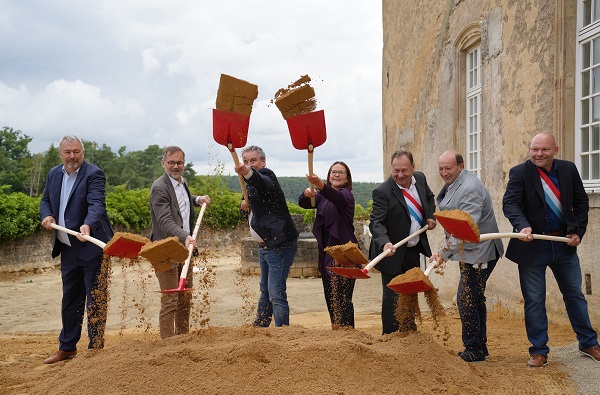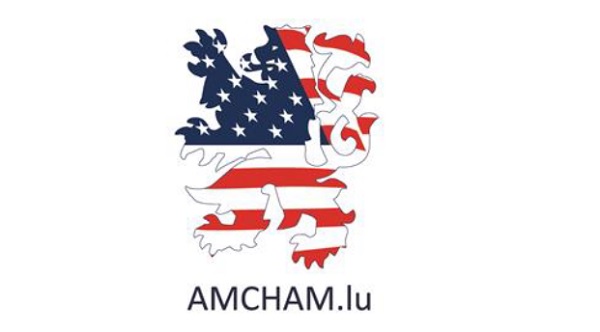 (L-R) n/a; Georges Metz, Director of SNJ; Claude Meisch, Minister of Education, Children & Youth; Yuriko Backes, Minister for Mobility & Public Works; Paul Mangen, Mayor of Helperknapp; Emile Splicks, Helperknapp alderman; Ben Baus, Helperknapp alderman;
Credit: © MMTP
(L-R) n/a; Georges Metz, Director of SNJ; Claude Meisch, Minister of Education, Children & Youth; Yuriko Backes, Minister for Mobility & Public Works; Paul Mangen, Mayor of Helperknapp; Emile Splicks, Helperknapp alderman; Ben Baus, Helperknapp alderman;
Credit: © MMTP
On Wednesday 23 July 2025, the groundbreaking ceremony for the renovation and expansion of the National Youth Service (Service national de la jeunesse - SNJ) centre in Hollenfels took place in the presence of Luxembourg's Minister for Mobility and Public Works, Yuriko Backes, and Minister of Education, Children and Youth, Claude Meisch, as well as Helperknapp Mayor Paul Mangen and SNJ Director Georges Metz.
Minister Backes highlighted that "the work carried out is part of the government's commitment to continuing its investments in quality infrastructure that respects both the built and archaeological heritage as well as environmental aspects and, where appropriate, offers modern, sustainable and comfortable educational and leisure facilities that meet the expectations and needs of our young citizens. In this sense, I am delighted that the project owner has successfully combined modern and sustainable operations with architectural and historical respect."
Hollenfels Castle is located in the municipality of Helperknapp, in the heart of the "Valley of the Seven Castles". Listed as a national monument since 2022, the entire site, designated the Hollenfels Youth Centre, comprises three major entities: the castle with its keep, the youth hostel and the grounds. In 1948, the site was acquired by the Luxembourg State, which entrusted it to the Luxembourg Youth Hostels (Auberges de Jeunesse Luxembourgeoises - AJL). In 1975, the site was assigned to the SNJ, which has since operated the keep and castle as an educational centre dedicated to sustainable development. The AJL continues to operate the buildings located on the village side.
According to Luxembourg's respective ministries of mobility, education and culture, and the SNJ, the renovation and extension project aims to improve accessibility and regulatory compliance for all buildings, as well as to modernise and restore the historic structures by adding extensions to the youth hostel and the castle.
Except for the forester's house, the 1960s youth hostel is being completely restructured and rebuilt to meet current standards and regulations. All 30 rooms will be standardised with four beds and private bathrooms, including two for guests with reduced mobility. Accessibility for people with reduced mobility will be ensured on all levels, including via a lift.
The facility will also include a bistro and a restaurant with a panoramic terrace overlooking the castle and keep, both open to the public. A bicycle garage for visitors will be integrated into the forester's house, and car park will offer space for 20 cars and two coaches. Ten workshop and seminar rooms, as well as the administrative offices, will remain located within the historic keep and castle.
The relevant ministries and the SNJ noted that the architectural approach is based on a dialogue between heritage conservation and contemporary interventions while emphasising its environmental dimension: the use of ecological materials ensuring high-quality thermal insulation for the walls and roof, rainwater harvesting for the bathrooms and watering the green facades, and the integration of photovoltaic panels are all elements that complete an energy-efficient and ecological concept that is said to be in line with the philosophy of sustainable development education promoted by the Hollenfels centre.
In his remarks, Minister Meisch underlined the importance of creating dedicated spaces where youth work can flourish. He also emphasised the relevance of the themes developed at the centre, particularly sustainable development education, which he described as a major challenge in preparing young people to become responsible and engaged citizens.
The SNJ and the ministries recalled that recent archaeological discoveries made at Hollenfels underscore the exceptional importance of this site for national cultural heritage. Designated as a national monument, the castle and its surroundings have revealed, thanks to excavations carried out since 2024, remarkably well-preserved medieval structures: a complex fortification system, a double line of ditches, the remains of previously unknown bridges, as well as numerous artefacts found and preserved in a humid environment (wooden elements, shoes, coins, cannonballs, a mill game, etc). These findings confirm the scientific and historical interest of the site and highlight the need to closely integrate the protection and enhancement of this heritage into the renovation project, in order to preserve this unique testimony to Luxembourg's fortified history for future generations.
The renovation and extension project costs €31.9 million (including tax), with the Ministry of Mobility and Public Works and the Public Building Administration acting as the project owners.








